#ancient spanish history
Text

Death of Sappho, Miquel Carbonell Selva, 1881
#art#art history#Miquel Carbonell Selva#historical painting#ancient history#Ancient Greece#Sappho#Death of Sappho#Spanish art#Catalan art#19th century art#oil on canvas#death tw
6K notes
·
View notes
Text


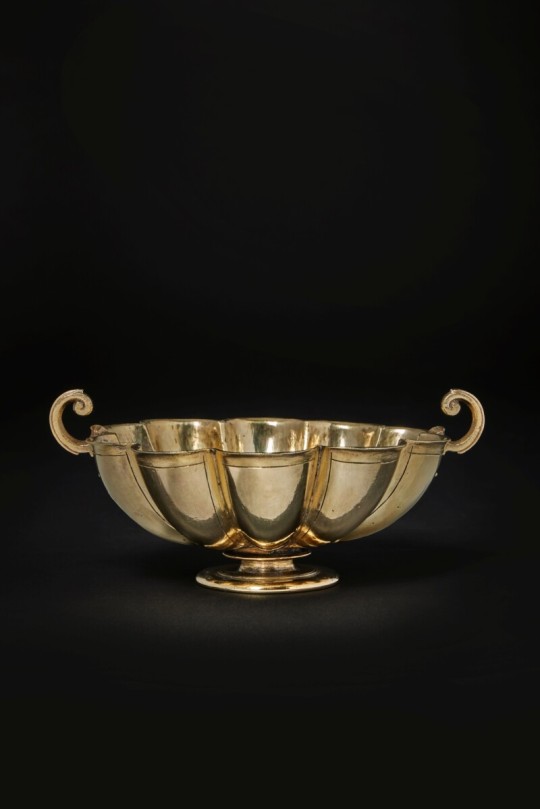
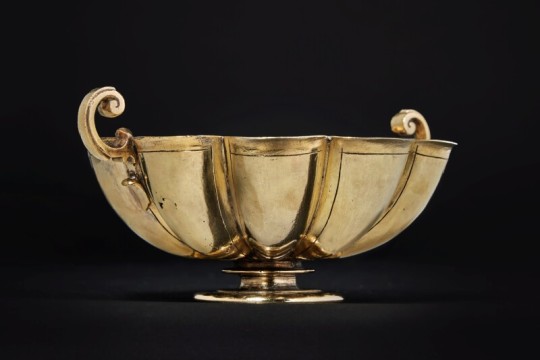
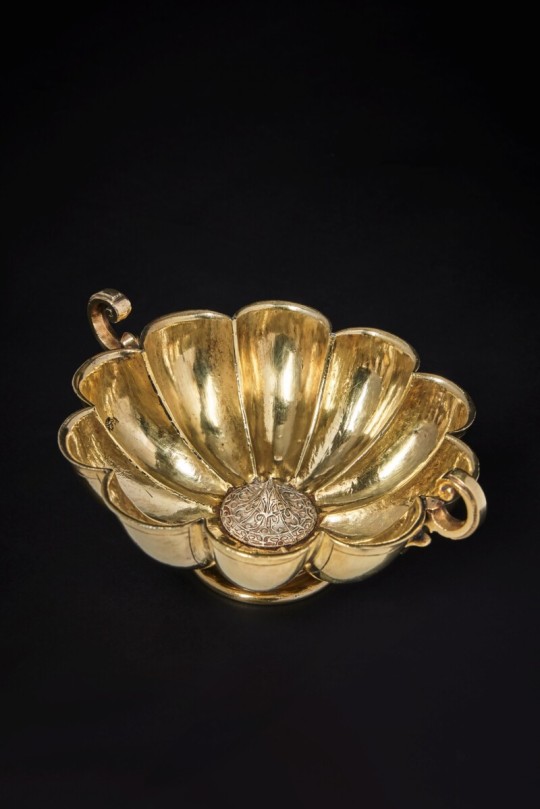
A Rare Spanish Colonial Silver-Gilt Two-Handled Cup from the Atocha Shipwreck
Bogotá, Colombia, circa 1620
Nuestra Señora de Atocha was a Spanish treasure galleon and the most widely known vessel of a fleet of ships that sank in a hurricane off the Florida Keys in 1622. At the time of her sinking, Nuestra Señora de Atocha was heavily laden with copper, silver, gold, tobacco, gems, and indigo from Spanish ports at Cartagena and Porto Bello in New Granada (present-day Colombia and Panama, respectively) and Havana, bound for Spain. The Nuestra Señora de Atocha was named for the Basilica of Nuestra Señora de Atocha in Madrid, Spain. It was a heavily armed Spanish galleon that served as the almirante (rear guard) for the Spanish fleet. It would trail behind the other ships in the flota to prevent an attack from the rear.
Much of the wreck of Nuestra Señora de Atocha was famously recovered by an American commercial treasure hunting expedition in 1985. Following a lengthy court battle against the State of Florida, the finders were ultimately awarded sole ownership of the rights to the treasure.
#A Rare Spanish Colonial Silver-Gilt Two-Handled Cup from the Atocha Shipwreck#Bogotá Colombia#circa 1620#Atocha#Nuestra Señora de Atocha#Spanish treasure galleon#treasure#shipwreck#silver#ancient artifacts#archeology#archeolgst#history#history news#art#antique
68 notes
·
View notes
Text
Notes on Anitismo - The Ancient Religion of the Philippines by Isabelo de los Reyes.

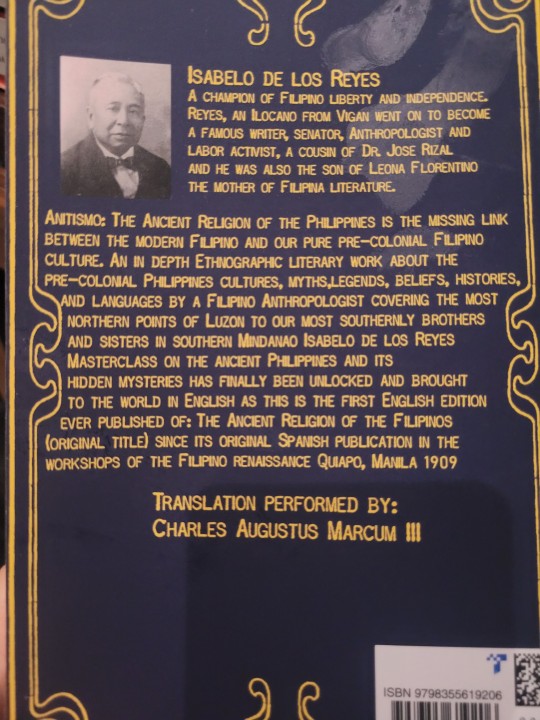
Keep in mind - this was written a while back.
Ancient Chronicles written by the Jesuit hispanic Friars state that at the that the first spaniards set foot in the Philippines from the coast of visayas to Manila there was a considerable population of Muslim converts
This was especially true for Mindanao due to conversion by Islamic teachers from Borneo
De los Reyes argues that because of this, to find native Filipino religion at its purest, we must look to the North
Distinguishing native religion without outside influence such as from Islam, Hinduism, Christianity etc can be tricky
However he argues that the traces of Native Filipino religion can be found in the stories superstitions and advice that belong to various Filipino ethnic groups (Tagalogs, Bicolanos, Zambalenos etc)
From the South of the country in Mindanao to the extreme North like Luzon, De los Reyes argues then native Filipino religion was consistent
This religion was Anitism or the Cult of Anito, meaning souls of the ancestors.
Anitism is not a monolithic religion and hosts a broad pantheon ranging from Gods to animals, nature, elements and space.
The Philippines had its own modern spiritism and De los Reyes argues this may have been the origins of the cults of "Romanist Saints" (Catholic saints) in the Philippines. By this I think he means that Filipino spirituality influenced how Filipinos proceeded with Catholic worship.
The oldest chronicles about the Philippines can be found in various museums and libraries (such as the National Library of Madrid, Covenant of St Augustine in Manila)
We can follow these chronicles, from when the Jesuit Pedro Quirino provided news of religion in the Philippines in 1604, followed by reproductions by others like the Jesuit Colin in 1663 and others such as Fr. Morga, Gonzalez de Mendoza, Aduarte etc.
Fr Morga said that Filipinos practised Anitism in certain regions like Camarines and Cagayan.
Some traditions would say that Manila and its regions were not originally native to the island - they were from Malayan islands and other remote areas.
Before the Spaniards arrived, Islamic teachers from Borneo came to preach and interacted with the locals
Their teachings and beliefs spread quickly throughout the Philippines
Fr. Grijalva writes that they (Filipinos) started adopting their traditions and took on their names.
De Los Reyes argues that Spanish conquistadors' arrival/conquest was delayed because Filipinos were already familiar with various religions and beliefs and also because of the hands of Datu Lapu Lapu. What I believe he is arguing is that Datu Lapu Lapu and the previous exposure Filipinos had to different religions at first delayed Spanish influence from spreading so quickly.
Other islanders who weren't under the control of the government in the Philippines has their beliefs influenced by religious preachers who travelled to them from the Straits of Malacca and the Red Sea.
An account, dated April 20th 1572 (preserved in the archives of India) which is from the conquest of Luzon details "In these towns, closest to the sea, they do not eat any pork, which the moors taught them. But if you ask them, they say they do not know Muhammed or his law." This account was reproduced by Wenceslao Retana.
In actuality, very few Filipinos could understand/read the teachings of the Koran despite the Islamic influence.
In Filipino traditions, reverence and worship was given to nature and the elements, and this was usually consistent throughout the islands.
Native Filipino religion beliefs include elements, animals, stars and ancestors.
Filipino religion in Manila and nearby areas was a mixture or Anitism, Buddhism, Hinduism and Islam brought by the Malays of Borneo.
Vocabulary included Sanskrit and Malay terms such as Bathala, meaning Lord.
However these terms are not used in Northern provinces.
De Los Reyes argues that Itnegs and other mountain tribes conserved and maintained the purest form of Filipino religion
In the Ilocos, Cagayan, Isabela and other provinces of Northern Luzon, native Filipino religion was more prevalent
Hindus and Buddhists converted many in Java and Malaysia.
However Muslim influence became dominant in 1478 - 60 years before the Dutch invasion.
According to Javanese legends, Hindus arrives in Java 78 years before Christ.
The first Malays came from the Minangkabau river region to establish cities in Malacca , Ojohor and Singapore in the 12th century, as per Malacca records.
In the 13th, 14th and 15th centuries, there were various Malaysian emigrations reaching the Philippines
De Los Reyes argues that Filipinos may have also populated the islands of Malaysia, and emigrations could have originated from strong winds coming down from the North.
The first Spaniards found the son of Lakandula, King of Manila, when they went to Borneo.
The emperor's master of ceremonies from Japan (Mr Fujita) argued that emigration likely came from the north and that Filipinos may have some relations to the Japanese.
According to Geographers and Historians of the Mariana Islands, what De Los Reyes calls the "know it all Spanish" - had no idea about interesting ruins found in Oceania, one of which was a prehistoric statue that was being held in the British museum.
He argues there may be hidden megaliths, artefacts, and remnants of lost civilisation in the Philippines, as seen in various locations such as : Butacan caves, Pangibalon Hill, Madias de Iloilo and Nasso.
#Philippines#pre colonial philippines#Filipino#Filipino history#Anitism#Filipino religion#Pinoy#Isabelo de los Reyes#History#Asia#Asian history#South east Asian history#Religion#ancient religion#South east asia#Colonialism#spanish colonial#Spanish colonialism#Philippines history#Philippine history#Anitismo#Keep in mind this was written a while ago so some terms may be outdated#I've tried to interpret some tricky parts the best I could#My ass who is from the Northern Philippines 🗿
51 notes
·
View notes
Text
Gaztelugatxe, of the Basque country, played the role of Dragonstone in HBO’s Game of Thrones. The real history of this little islet is just as fascinating as anything from the show.
#Gaztelugatxe#Game of Thrones#John the Baptist#Chapel#Spanish Inquisition#Spain#islet#ancient#history#ancient origins
16 notes
·
View notes
Text

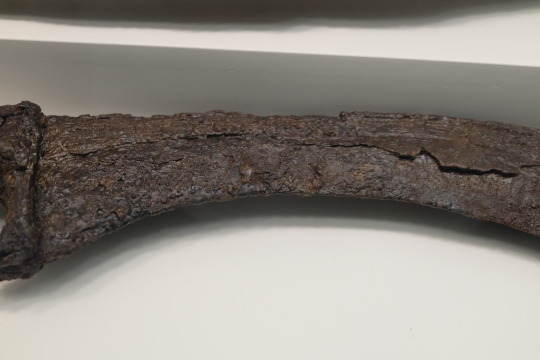

Falcata Sword from the tomb of Coimbra del Barranco, Spain dated to the 4th Century on display at the Museum of the Army in Toledo, Spain
This type of sword was common in Pre-Roman Iberia now modern day Spain and became very popular with Hannibal of Carthage and the Carthaginian army during the Second Punic War. The name Falcata is not native to the Celtiberian language nor any classical sources but comes from the 19th century historian Fernando Fulgosio who described it as "Falcon shaped"
The Falcata style of sword was thought to have been introduced by the Celts who also introduced iron working to this region. Though it is similar it is thought to have been made in parallel to the Greek Kopis which is very similar. The main difference being that the Falcata blade is double edged for about half its lengths.
Photographs taken by myself 2019
#sword#celt#celtic#ancient#iron age#spain#spanish#military history#museum of the army#toledo#barbucomedie
48 notes
·
View notes
Photo

The names of the tribes of nowadays Euskal Herria in Roman times.
According to Julius Caesar, the Aquitanii weren’t Gauls, but a different people; they’re believed to be relatives of the Vasconi, and academic discussion goes on about the Celtic or Vasconic origin of Autrigones, Caristii and Vardulii.
#euskadi#euskal herria#basque country#pais vasco#pays basque#iparralde#history#tribes#roman times#map#ancient people#spanish
204 notes
·
View notes
Photo

Francisco Collantes (Spanish, 1599 - 1656)
Paisaje con un castillo, 17th century
Museo Del Prado
#spanish art#spain#castle#ancient history#ancient world#world history#classical art#classical#europe#european art#european#paisaje#pintura paisaje#paisaje con un castillo#art#fine art#fine arts#landscape#oil painting#traditional art
32 notes
·
View notes
Text
Taharqa Invades Spain

The young Prince Taharqa of Kush, fated to become king of an empire that spreads from his homeland in Sudanese Nubia all the way down to the Nile Delta, leads an invasion of southern Spain circa 700 BC. This is of course another alternate history scenario, but the inspiration came from a handful of apocryphal accounts from historians such as Strabo and Ahmed ibn Mohammed al-Makhari that report that he ventured to the “pillars of Heracles” (the Gibraltar Strait between Spain and Morocco) and led an expedition into Spain. Archaeological evidence of such Kushite forays remains undiscovered, but considering that the Phoenicians from Lebanon had already established trading posts on the Spanish coast as far afield as modern Cadiz by that time, an army from the Nile Valley making it there is not totally impossible. Who knows, maybe Taharqa and his soldiers here are defending one of the Phoenician settlements from hostile local tribes?
#Taharqa#nubian#kushite#25th dynasty of Egypt#sudanese#african#black men#dark skin#spain#spanish#iberian#ancient#battle#alternate history#digital art#art
0 notes
Video
youtube
Unlocking the Enigma: Journey Through the Inca Empire's Rich History!
The Inca Empire, nestled in the heart of the Andes Mountains, stands as a testament to ancient ingenuity, cultural brilliance, and the relentless march of time. This documentary promises an immersive exploration, spanning the rise and fall of the Inca Empire, shedding light on mysterious tales, and unraveling the secrets of a lost civilization.
At the core of our historical odyssey is the architectural marvel that defined the Inca Empire. From the iconic Machu Picchu to the intricate road systems connecting the vast expanse of the empire, the Inca's engineering prowess was unparalleled. The documentary showcases these wonders, inviting viewers to marvel at the sophistication of a civilization that thrived amidst challenging mountainous terrain.
Central to the narrative is the Spanish conquest that forever altered the course of Inca history. The clash of civilizations, the strategies employed, and the inevitable fall of the empire are explored in vivid detail. Viewers will witness the pivotal moments that shaped the destiny of the Inca people, pondering the 'what ifs' of history had the empire survived.
In a captivating segment, the documentary introduces a 15-year-old girl who lived within the Inca Empire. Her story unfolds against the backdrop of daily life, cultural richness, and the challenges faced by individuals during this time. It adds a personal touch, offering a glimpse into the lives of those who walked the ancient streets of Cusco and gazed upon the wonders of their civilization.
Venturing further into the shadows of history, the film unveils the secrets of Inca mummies. These preserved remnants carry tales of rituals, beliefs, and practices that defined the spiritual fabric of the empire. The documentary carefully peels back the layers, providing insights into the mysteries surrounding these ancient remains.
Accompanied by a carefully curated musical journey, the documentary not only educates but also immerses viewers in the sounds that echoed through the Inca Empire. From the lofty heights of the Andes to the bustling streets of its cities, the soundtrack enhances the emotional resonance of the historical narrative.
In conclusion, this documentary is a comprehensive exploration of the Inca Empire's history, art, architecture, and culture. It invites viewers to question, reflect, and appreciate the enduring legacy of a civilization that has captivated the world for centuries. Subscribe now and embark on a journey through time, where the past comes alive, and the Inca Empire's mysteries are unveiled.
#youtube#inca empire#inca#the inca empire#spanish empire#inka empire#colonial empires#incan history#ancient history#history
0 notes
Text
Keep Your Friends Close; Keep Your Altepetl Closer (3/3)
All empires, regardless of power or influence, inevitably collapse. A widely-held misconception regarding The Aztec Empire is that the Aztecs fell victim to Spanish conquistadors, leading to the empire's downfall. Spanish conquistadors did play a role in Aztec collapse, but Spanish victory over the Aztecs was made possible by decades of altepetl attacks, slowly weakening the empire's military forces. Let's explore the role of altepetl in The Aztec Empire's decline, fueled by altepetl's religious resentments.

Conquering neighboring territories caused the Aztecs to receive divine praise from their gods and goddesses. Additionally, conquering neighboring territories caused the Aztecs to gain military power through recruitment of men from allied and conquered altepetl. As the Aztec military grew stronger, the civilization became increasingly inspired by both Huitzilopochtli, god of war, and personal motives to expand the empire. This expansion forced altepetl to produce routine material and human sacrifices to the Aztecs for the benefit of Aztec gods and goddesses. The Aztec Empire, on many occasions, stole slaves and prisoners from nearby tribes for ritualistic purposes. Consequently, many altepetl harbored religious resentments towards the Aztecs, and attempted to rebel against Aztec control. During the reign of Aztec ruler Montezuma II from 1503 to 1520, both the empire and altepetl rebellions were at their peaks.
Source: Laack, Isabel. Aztec Religion and Art of Writing: Investigating Embodied Meaning, Indigenous Semiotics, and the Nahua Sense of Reality. Brill, 2019. Print.

Image Source: “Montezuma II.” Wikipedia, Wikimedia Foundation, 2023, https://en.wikipedia.org/wiki/Moctezuma_II
Despite constant rebellions from altepetl, Montezuma II defeated neighboring tribes' attempts to gain sovereignty. Altepetl rebellions, however, significantly weakened The Aztec Empire through exhaustion of Aztec resources and military forces. Shortly after the altepetl rebellions, Spanish conquistador Hernán Cortez attempted to invade The Aztec Empire. Unstable relations between the Aztecs and conquered altepetl gave Cortez the opportunity to form alliances with altepetl, most notably the Tlaxcalans, known as long-term enemies of the Aztec, and strong war fighters. The Tlaxcalans were largely responsible for Cortez's later victory over The Aztec Empire. Towing a large army of angry natives into the Aztecs' capital city of Tenochtitlan, Cortez quickly imprisoned Montezuma II. The ruler eventually submitted to Spanish forces and, in doing so, lost the respect of the Aztec civilization. Spanish accounts claim Aztecs living in Tenochtitlan bombarded Montezuma II with stones and arrows during Montezuma II's frugal attempts to negotiate peace, causing Montezuma II to suffer fatal wounds. Aztec accounts claim Cortez murdered Montezuma II, causing the conquistador's regime to be nearly destroyed in exiting Tenochtitlan by the Aztec regime.
Source: Read, Kay Almere. Time and Sacrifice in the Aztec Cosmos. Indiana University Press, 1998. Print.
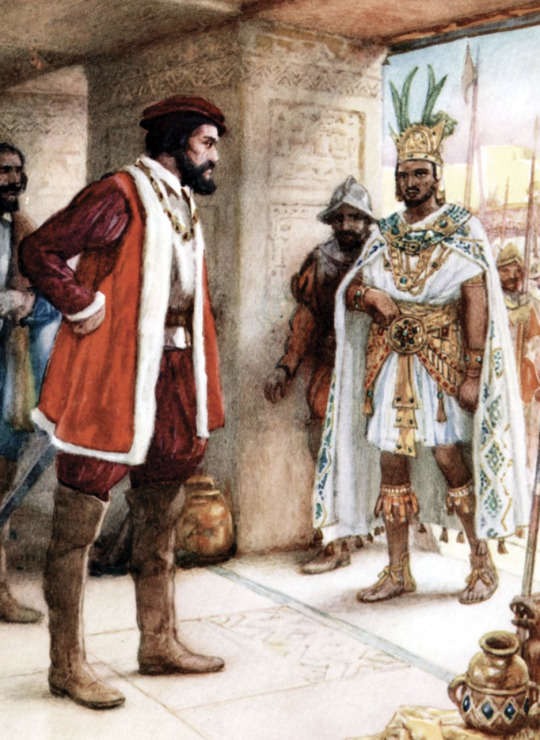
Image Source: Britannica Editors. “Montezuma II.” Encyclopædia Britannica, Encyclopædia Britannica, Inc., 2023, https://www.britannica.com/biography/Montezuma-II
The exact demise of Montezuma II remains uncertain. The role of religion in The Aztec Empire's decline and collapse remains absolute. In fact, the role of religion remains evident in all stages of the empire's lifespan. Religious ideals fueled constant need for war that subsequently expanded Aztec territory, religious allegiance gave the Aztecs leverage to maintain control over conquered altepetl, and religious resentments led to a weakening of The Aztec Empire, aiding overrule of Montezuma II by Spanish forces.
#imperialism#ancient history#history#colonialism#imperialists#aztecs#aztec empire#spanish#conquistadores#cortez#mythology#religion#mesoamerica#the americas#mexico#spain#all great things must come to an end#don't mess with altepetl#vulnerability is hard#embarrassing ends#nice guys finish first
1 note
·
View note
Text

#spain#photos#photography#nature photography#nature#culture#spanisj#spanish#spanish culture#barcelona#barcelona spain#ancient art#art history#history nerd#history
0 notes
Text


6,000-Year-Old Sandals Found in a Spanish Cave are Europe’s Oldest Shoes
New analysis has identified the oldest shoes ever discovered in Europe, according to a study published this week in the journal Science Advances.
The 22 woven sandals date from 6,000 years ago, radiocarbon analysis found in the study led by researchers at the Autonomous University of Barcelona and Alcalá University in Spain.
The ancient footwear, along with Mesolithic baskets and other tools, was first discovered back in 1857, when a cave in southern Spain was looted by miners. However, when the artifacts were first dated, in the 1970s, they were identified as being about 1,000 years more recent than this latest analysis found.
The very dry conditions within the cave were ideal for preserving perishable materials, the researchers said, and allowed the preservation of a prehistoric burial site complete with partially mummified corpses, accompanied by baskets, wooden tools, sandals and other goods.
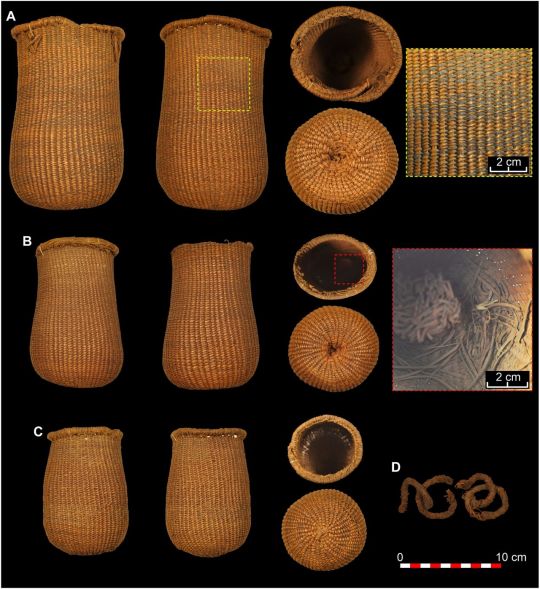

The objects are “the oldest and best-preserved set of plant fiber materials in southern Europe so far known,” María Herrero Otal, one of the study’s authors, said in a statement, adding that they demonstrate “the ability of prehistoric communities to master this type of craftsmanship.”
When Spanish archaeologist Manuel de Góngora y Martínez visited the cave in 1867, 10 years after the looting, he gathered the remaining artifacts, including the sandals, and gave them to museums in Madrid and Granada, where they have been studied by researchers, the study added.
The sandals were made of grasses as well as other materials, including leather, lime and ramie bast, a type of natural fiber.
Using the descriptions provided by Góngora, the study hypothesizes that the bodies were buried wearing the sandals.
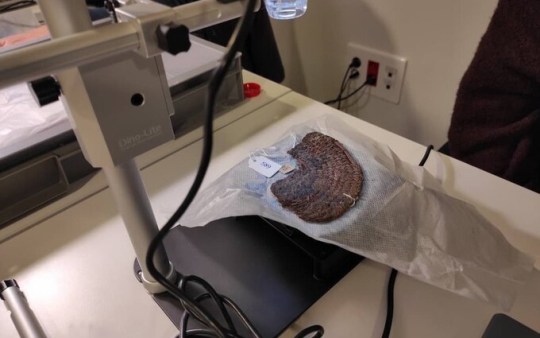
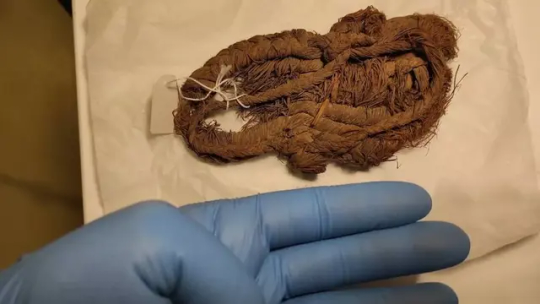
Some sandals had clear signs of wear, while others appeared never to have been worn, suggesting that some people had clothing made especially for their burial.
The researchers also studied several baskets and other wooden artifacts in the collection. These objects “open up groundbreaking perspectives on the complexity of Early-Middle Holocene populations in Europe,” they said, adding that most knowledge of past societies is drawn from durable artifacts rather than perishable ones such as baskets. The Holocene is the current geological epoch, which began 11,700 years ago.
Both the baskets and sandals suggest that the makers had an extended knowledge of the plant resources in the local environment as well as a high level of expertise, the researchers noted.
“The quality and technological complexity of the basketry makes us question the simplistic assumptions we have about human communities prior to the arrival of agriculture in southern Europe,” Francisco Martínez Sevilla, one of the study’s authors, said in a statement.
The study also found that the objects were deposited at the site at two very different times during the Early and Middle Holocene eras. The first phase was related to the Early Holocene hunter-gatherer populations, and the second phase to Middle Holocene farmers, researchers said.
By Issy Ronald.


#6000-Year-Old Sandals Found in a Spanish Cave are Europe’s Oldest Shoes#the oldest shoes ever discovered in Europe#Cueva de los Murciélagos#the Cave of the Bats#Andalusia Spain#ancient artifacts#archeology#archeolgst#history#history news#ancient history#ancient culture#ancient civilizations
128 notes
·
View notes
Note
Hi opencommunion - you are one of my favourite Tumblrs and I love hearing about Lebanese history from you. You say you are antiPhoenicianist - I hope you would tell us more about it. Hope you're having a great day.
aww thanks, I love your blog too <3
Phoenicianism is a Lebanese ethnonationalist ideology that basically argues that Lebanese people are ethnically/culturally unrelated to (and, implicitly or explicitly, superior to) not only other Arabs but other Levantine peoples. It's a secular ideology but it's extremely Islamophobic, so it posits that Lebanese Christians (especially Maronites) are the "purest" Lebanese people with a direct line of descent from the Phoenicians, who are portrayed as an almost supernaturally heroic and advanced culture who were supplanted by savage Arabs from the south (you probably recognize this as a Zionist talking point; more on that later). It's a narrative of Lebanese history that originates from rich European-educated Lebanese and their French & English orientalist buddies, and it bears all the hallmarks of European ethnonationalism and scientific racism. In my experience ascribing to Phoenicianism is associated with class and it doesn't represent the majority of Lebanese Maronites, who do consider ourselves Arabs. My family are dyed-in-the-wool Maronites from Wadi Qadisha, the cradle of Maronite culture, and for as far back as our family histories go we've always described ourselves as Arabs, with religion being the only difference—and an unimportant difference—between us and our Druze and Muslim neighbors.
Phoenicianism predates the Zionist occupation but it started to take shape around the same time as Zionism, and is based in the same core orientalist myth: that the ancient Levant was populated by strictly separate and homogenous ethnocultures with exclusive claim over portions of the land, which were later supplanted by Arab Muslim invaders who oppressed a tiny remaining local population. (In reality, of course, SWANA cultures have always been internally diverse and mutually influential, and "Arabization" in the Levant was characterized by organic cultural shifts among local populations, with Arab culture influencing and combining with local cultures rather than replacing them).
So when the Zionist settler project arrived they found easy allies in Phoenicianism. This relationship eventually culminated with the settler state backing the fascist Lebanese Phalanges Party (Kataeb in Arabic, a direct translation of Falange, the Spanish fascist party that inspired its founders) in the Lebanese Civil War. Israel used the Phalanges as a proxy to fight the Palestinian resistance in Lebanon, and it was Phalangists who collaborated with IOF to carry out the Sabra and Shatila massacres. This is the cruelest and ugliest moment in Lebanon's history and Phoenicianism enabled it; Phoenicianism enabled the cognitive dissonance necessary for Lebanese to participate in the occupation's genocide against our siblings and act as footsoldiers for the European fascist agenda in our region. The Phalangists and Zionists lost the war but there is still a Phalangist presence in the Lebanese government, and Phoenicianism is unfortunately alive and well among the Lebanese right wing at home and in the diaspora
381 notes
·
View notes
Text


Marble Statue from Corduba, Spain dated between 20-40 CE on display at the National Archaeological Museum in Madrid, Spain
This statue is of Livia portraying Fortuna or Copia. Livia was deified by her grandson, Emperor Claudius and was worshiped in the city as Fortuna, the goddess who gave men bounty and prosperity. The fruits of the earth held hn her cornucopia symbolise her power. This image, venerated in the imperial cult was an effective propoganda tool for legitimising the state's authority.
Photographs taken by myself 2019
#art#archaeology#roman empire#spain#spanish#1st century#ancient#history#national archaeological museum#madrid#barbucomedie
68 notes
·
View notes
Text
Since my big Languages and Linguistics MEGA folder post is approaching 200k notes (wow) I am celebrating with some highlights from my collection:
Africa: over 90 languages so far. The Swahili and Amharic resources are pretty decent so far and I'm constantly on the lookout for more languages and more resources.
The Americas: over 100 languages of North America and over 80 languages of Central and South America and the Caribbean. Check out the different varieties for Quechua and my Navajo followers are invited to check out the selection of Navajo books, some of which are apparently rare to come by in print.
Ancient and Medieval Languages: "only" 18 languages so far but I'm pretty pleased with the selection of Latin and Old/Middle English books.
Asia: over 130 languages and I want to highlight the diversity of 16 Arabic dialects covered.
Australia: over 40 languages so far.
Constructed Languages: over a dozen languages, including Hamlet in the original Klingon.
Creoles: two dozen languages and some materials on creole linguistics.
Europe: over 60 languages. I want to highlight the generous donations I have received, including but not limited to Aragonese, Catalan, Occitan and 6 Sámi languages. I also want to highlight the Spanish literature section and a growing collection of World Englishes.
Eurasia: over 25 languages that were classified as Eurasian to avoid discussions whether they belong in Europe or Asia. If you can't find a language in either folder it might be there.
History, Culture, Science etc: Everything not language related but interesting, including a collection of "very short introductions", a growing collection of queer and gender studies books, a lot on horror and monsters, a varied history section (with a hidden compartment of the Aubreyad books ssshhhh), and small collections from everything like ethnobotany to travel guides.
Jewish Languages: 8 languages, a pretty extensive selection of Yiddish textbooks, grammars, dictionaries and literature, as well as several books on Jewish religion, culture and history.
Linguistics: 15 folders and a little bit of everything, including pop linguistics for people who want to get started. You can also find a lot of the books I used during my linguistics degree in several folders, especially the sociolinguistics one.
Literature: I have a collection of classic and modern classic literature, poetry and short stories, with a focus on the over 140 poetry collections from around the world so far.
Polynesia, Micronesia, Melanesia: over 40 languages and I want to highlight the collection for Māori, Cook Islands Māori and Moriori.
Programming Languages: Not often included in these lists but I got some for you (roughly 5)
Sign Languages: over 30 languages and books on sign language histories and Deaf cultures. I want to highlight especially the book on Martha's Vineyard Sign Language and the biography of Laura Redden Searing.
Translation Studies: Everything a translation student needs with a growing audiovisual translation collection
And the best news: the folders are still being updated regularly!
2K notes
·
View notes
Text
How I teach the Iliad in highschool:
I’ve taught the Iliad for over a decade, I’m literally a teacher, and I can even spell ‘Iliad’, and yet my first instinct when reading someone’s opinions about it is not to drop a comment explaining what it is, who ‘wrote’ it, and what that person’s intention truly was.
Agh. <the state of Twitter>
The first thing I do when I am teaching the Iliad is talk about what we know, what we think we know, and what we don’t know about Homer:
We know -
- 0
We think we know -
- the name Homer is a person, possibly male, possibly blind, possibly from Ionia, c.8th/9th C BCE.
- composed the Iliad and Odyssey and Hymns
We don’t know -
- if ‘Homer’ was a real person or a word meaning singer/teller of these stories
- which poem came first
- whether the more historical-sounding events of these stories actually happened, though there is evidence for a similar, much shorter, siege at Troy.
And then I get out a timeline, with suggested dates for the ‘Trojan war’ and Iliad and Odyssey’s estimated composition date and point out the 500ish years between those dates. And then I ask my class to name an event that happened 500 years ago.
They normally can’t or they say ‘Camelot’, because my students are 13-15yo and I’ve sprung this on them. Then I point out the Spanish Armada and Qu. Elizabeth I and Shakespeare were around then. And then I ask how they know about these things, and we talk about historical record.
And how if you don’t have historical record to know the past, you’re relying on shared memory, and how that’s communicated through oral tradition, and how oral tradition can serve a second purpose of entertainment, and how entertainment needs exciting characteristics.
And we list the features of the epic poems of the Iliad and Odyssey: gods, monsters, heroes, massive wars, duels to the death, detailed descriptions of what armour everyone is wearing as they put it on. (Kind of like a Marvel movie in fact.)
And then we look at how long the poems are and think about how they might have been communicated: over several days, when people would have had time to listen, so at a long festival perhaps, when they’re not working. As a diversion.
And then I tell them my old and possibly a bit tortured simile of ‘The Pearl of Myth’:
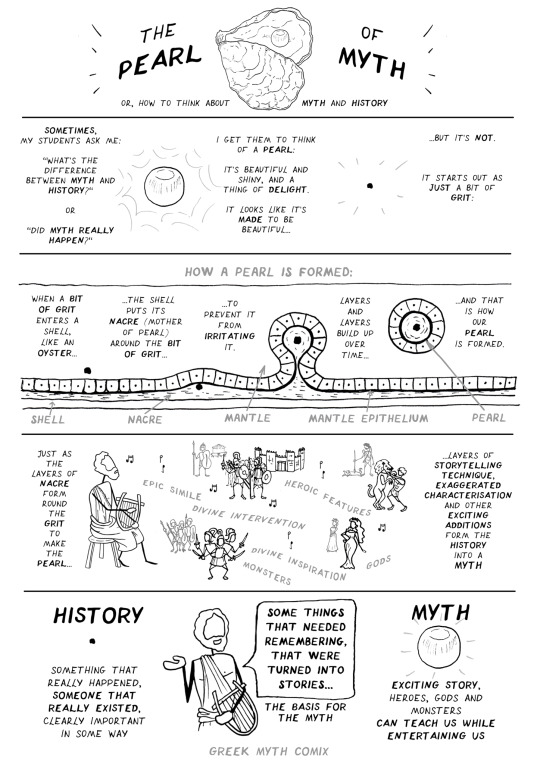
(Here’s a video of The Pearl of Myth with me talking it through in a calming voice: https://youtu.be/YEqFIibMEyo?sub_confirmation=1
youtube
And after all that, I hand a student at the front a secret sentence written on a piece of paper, and ask them to whisper it to the person next to them, and for that person to whisper it to the next, and so on. You’ve all played that game.
And of course the sentence is always rather different at the end than it was at the start, especially if it had Proper nouns in it (which tend to come out mangled). And someone’s often purposely changed it, ‘to be funny’.
And we talk about how this is a very loose metaphor for how stories and memory can change over time, and even historical record if it’s not copied correctly (I used to sidebar them about how and why Boudicca used to be known as ‘Boadicea’ but they just know the former now, because Horrible Histories exists and is awesome)
And after all that, I remind them that what we’re about to read has been translated from Ancient Greek, which was not exactly the language it was first written down in, and now we’re reading it in English.
And that’s how my teenaged students know NOT TO TAKE THE ILIAD AS FACT.
(And then we read the Iliad)
#man this week has been hard for classics teachers#Iliad#greek mythology#tagamemnon#greek myth#odyssey#homer#greek myth retellings#comix#greek myth comix#classics teacher#teaching#myth#history#ancient greek history#horrible histories#the idiots#teaching resources#teacher rant#Youtube
884 notes
·
View notes